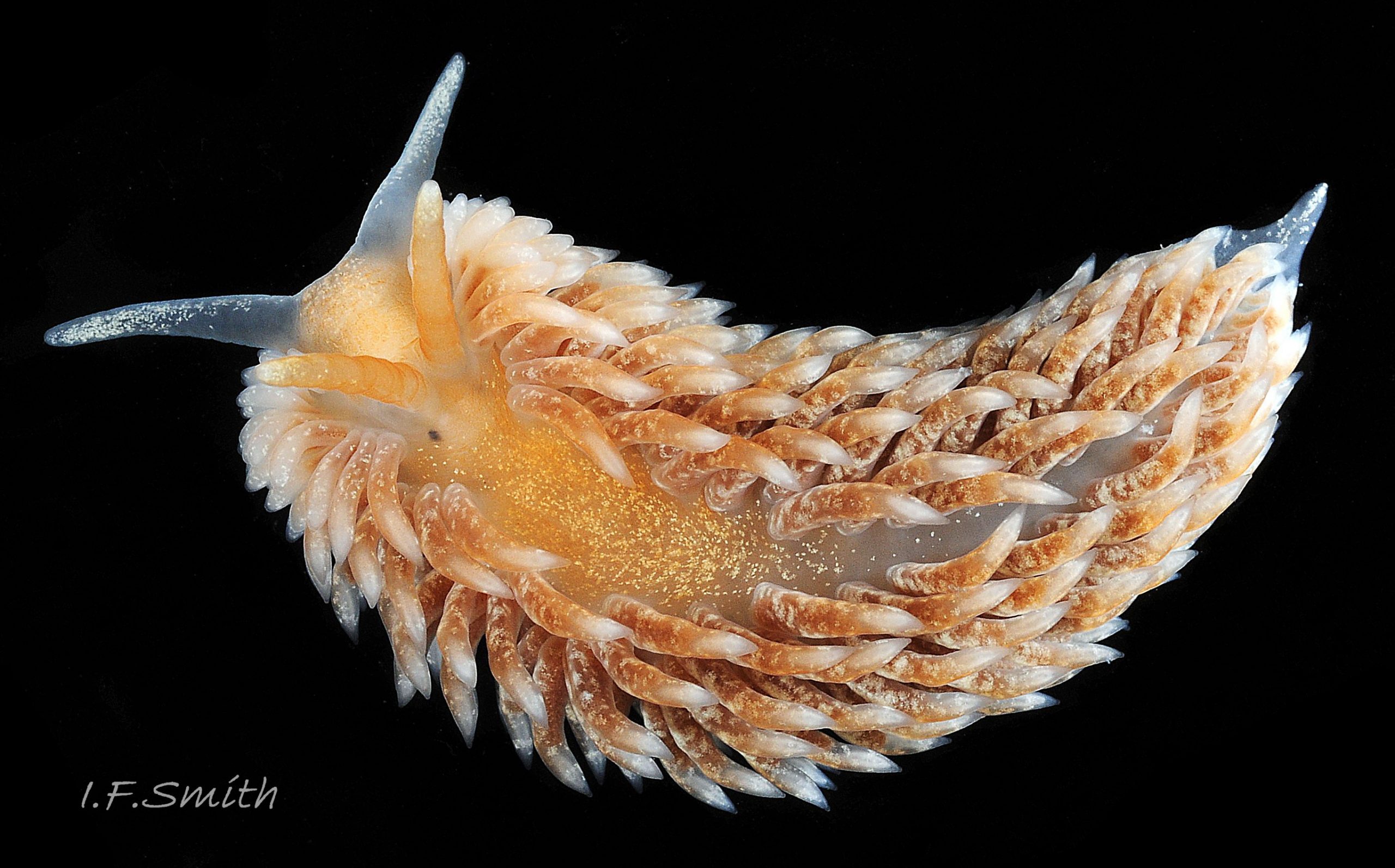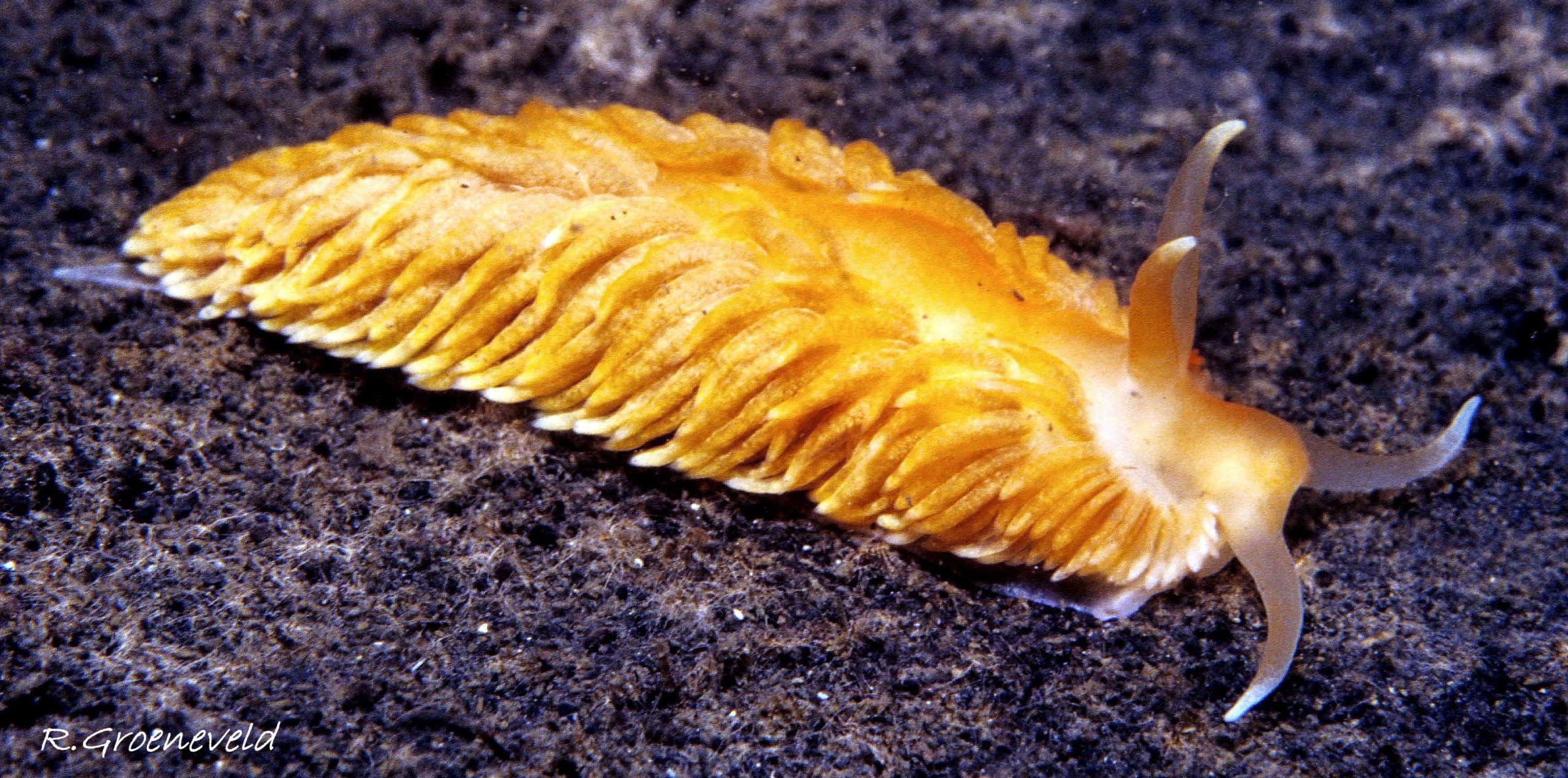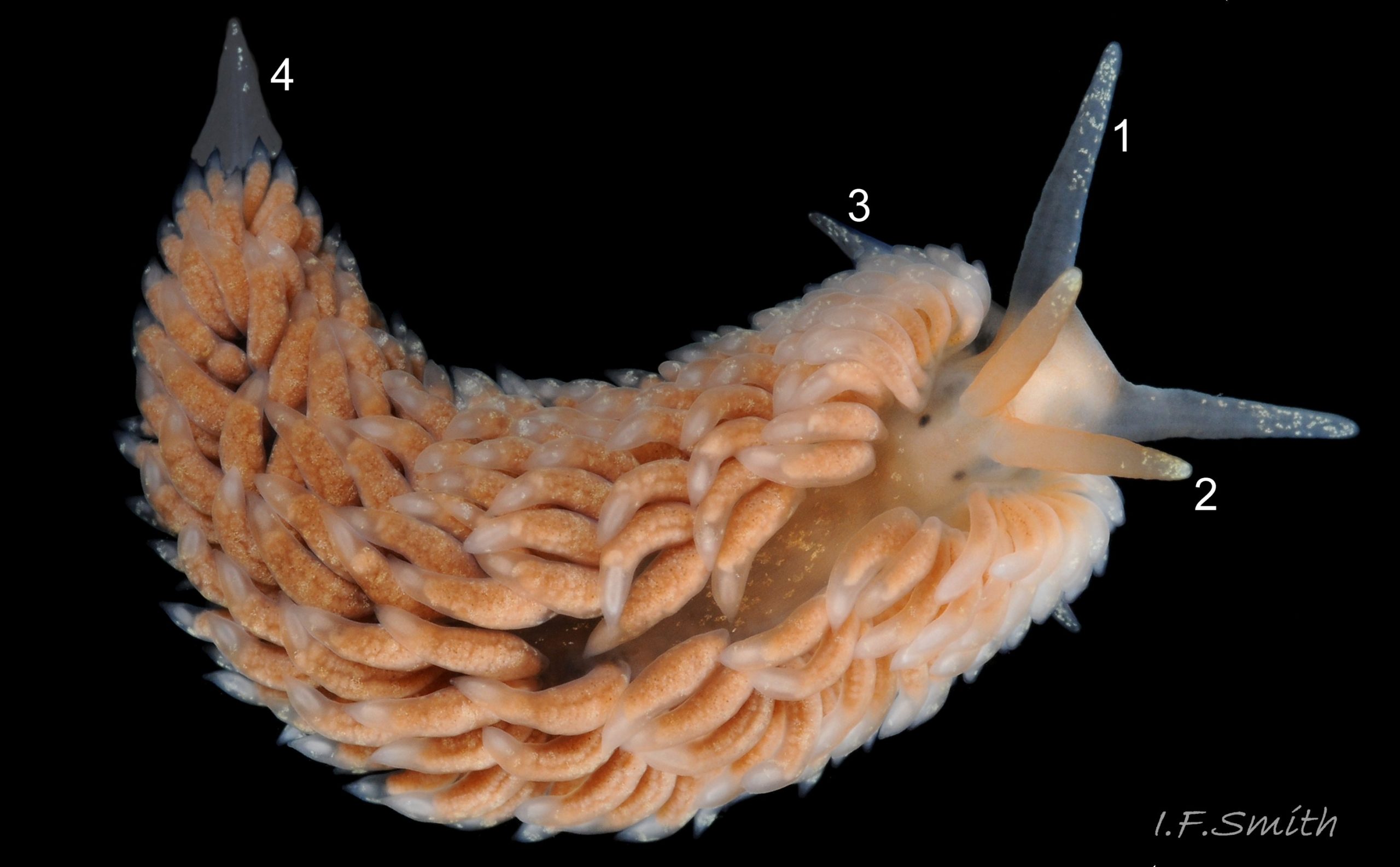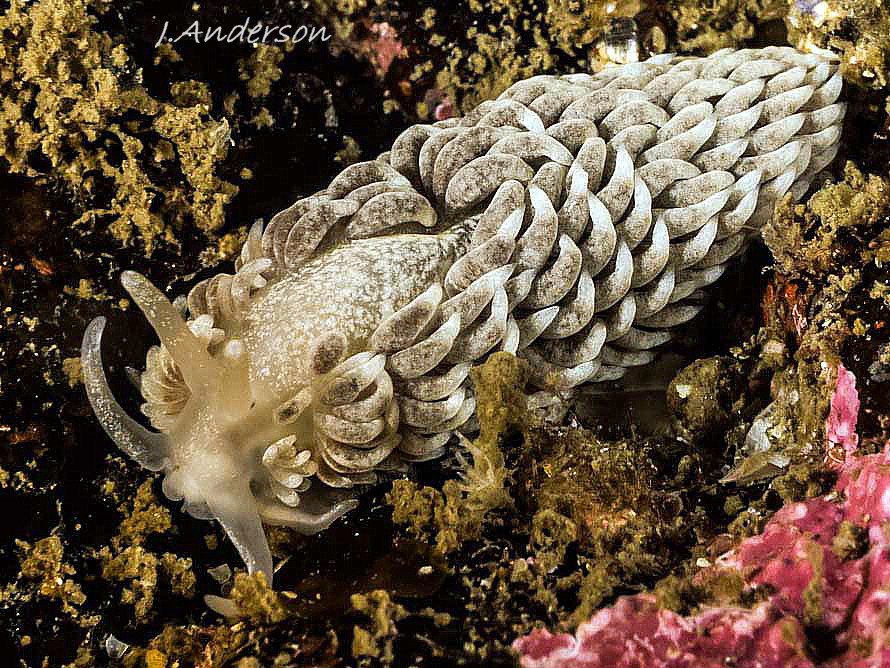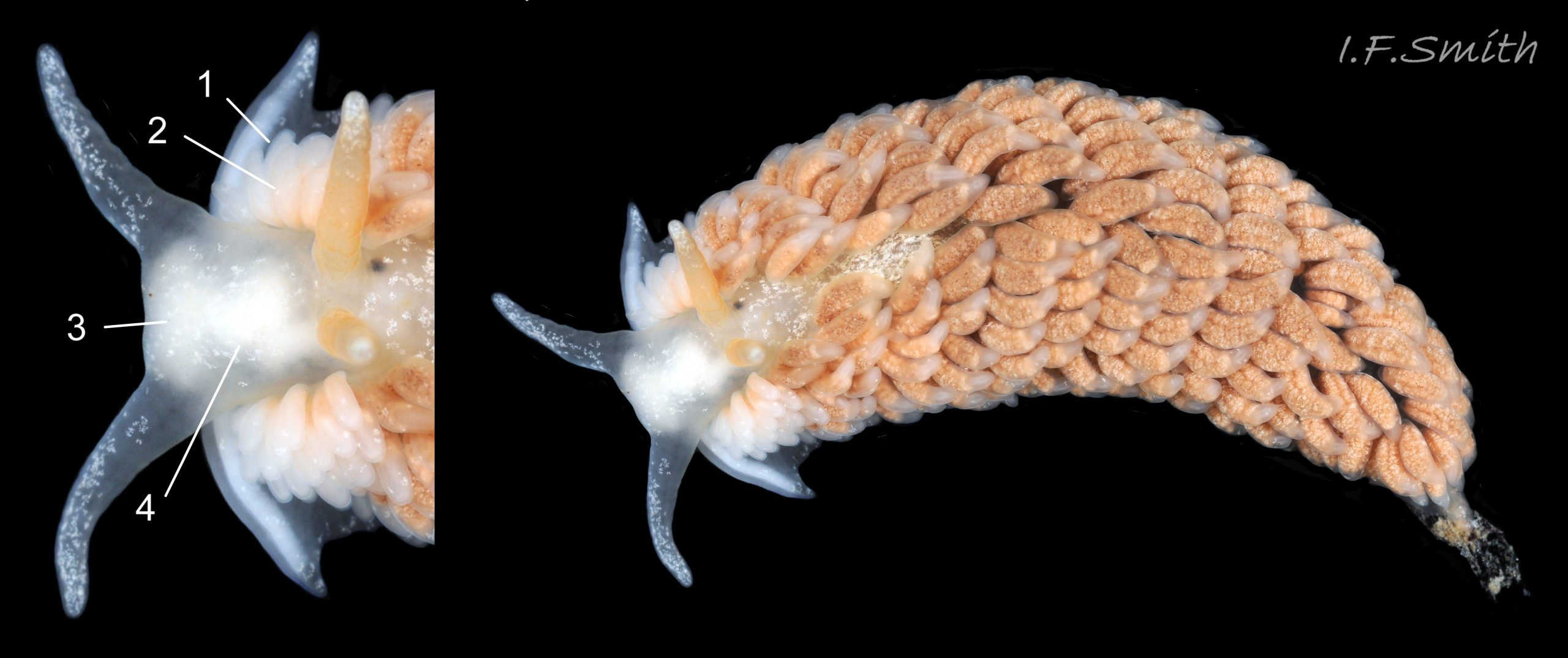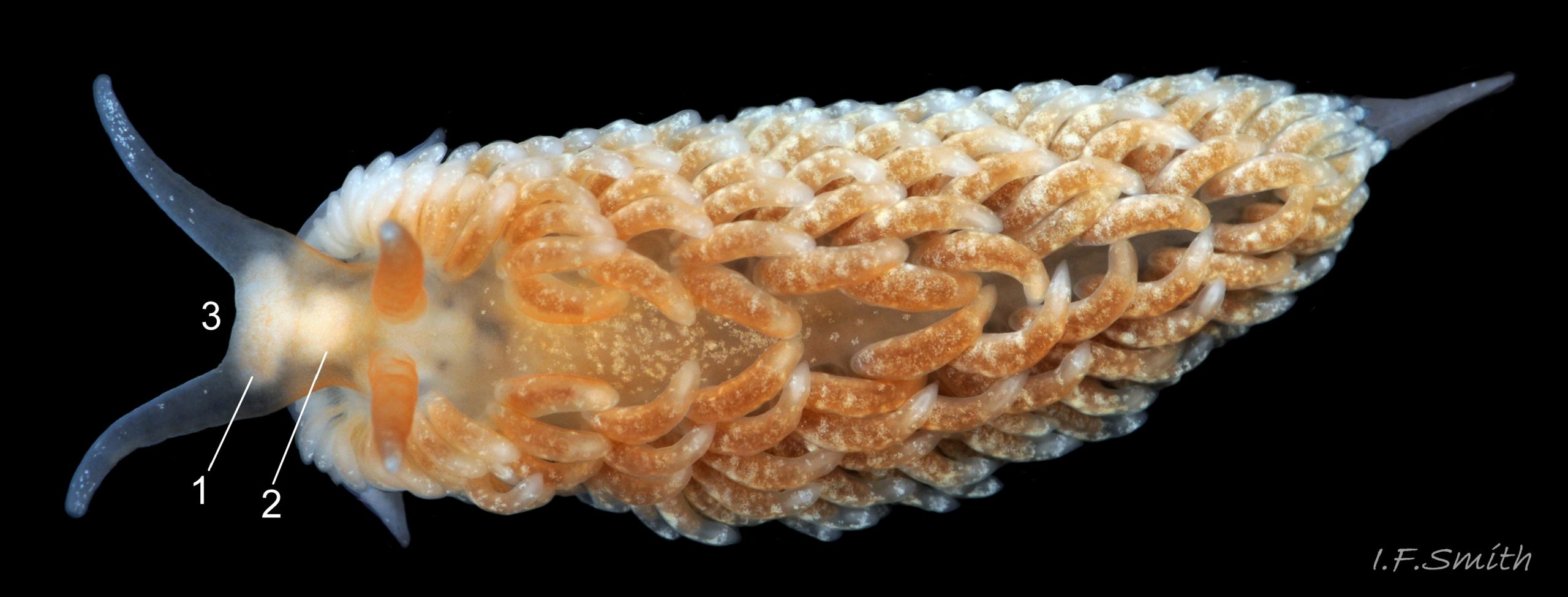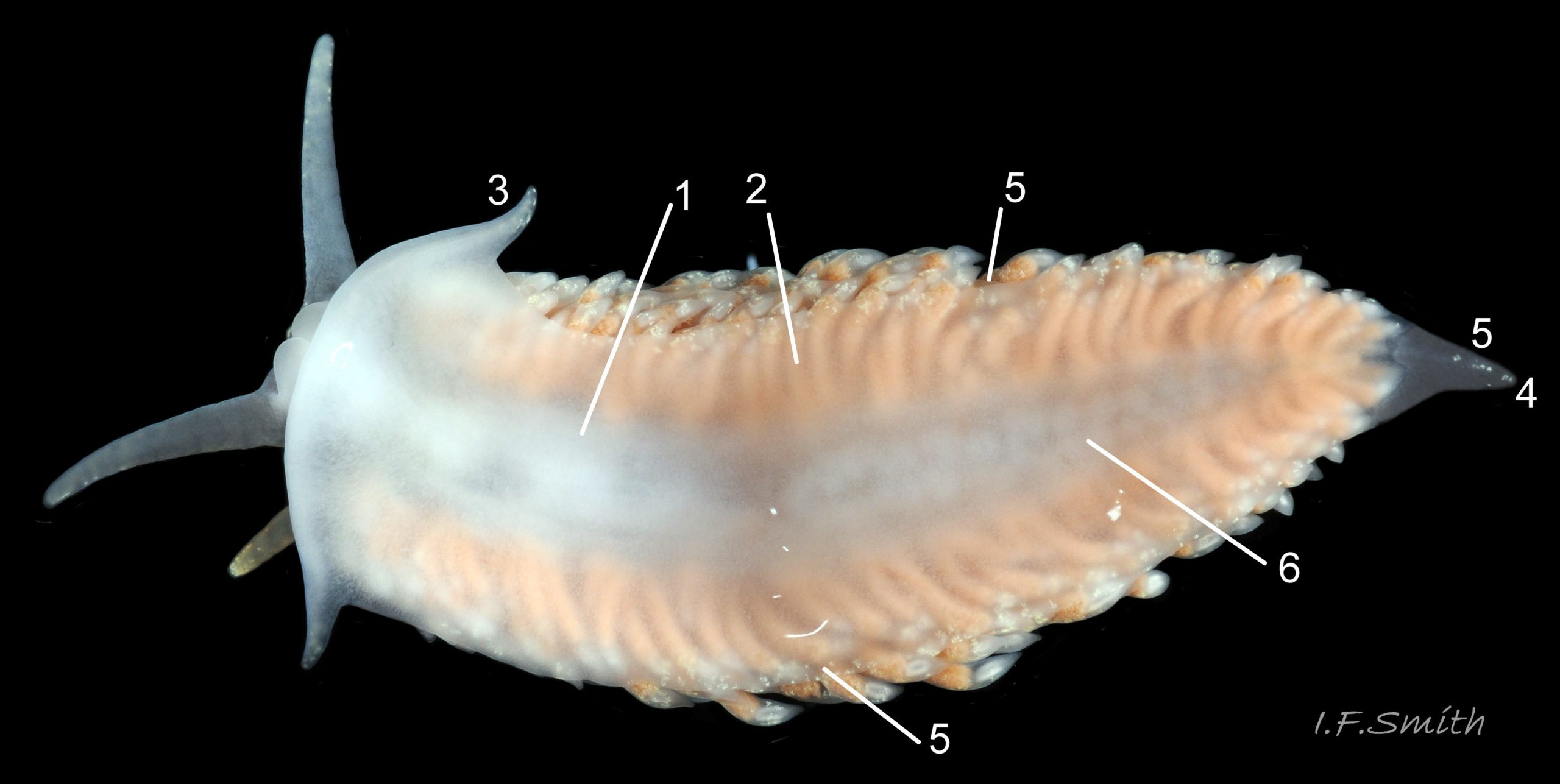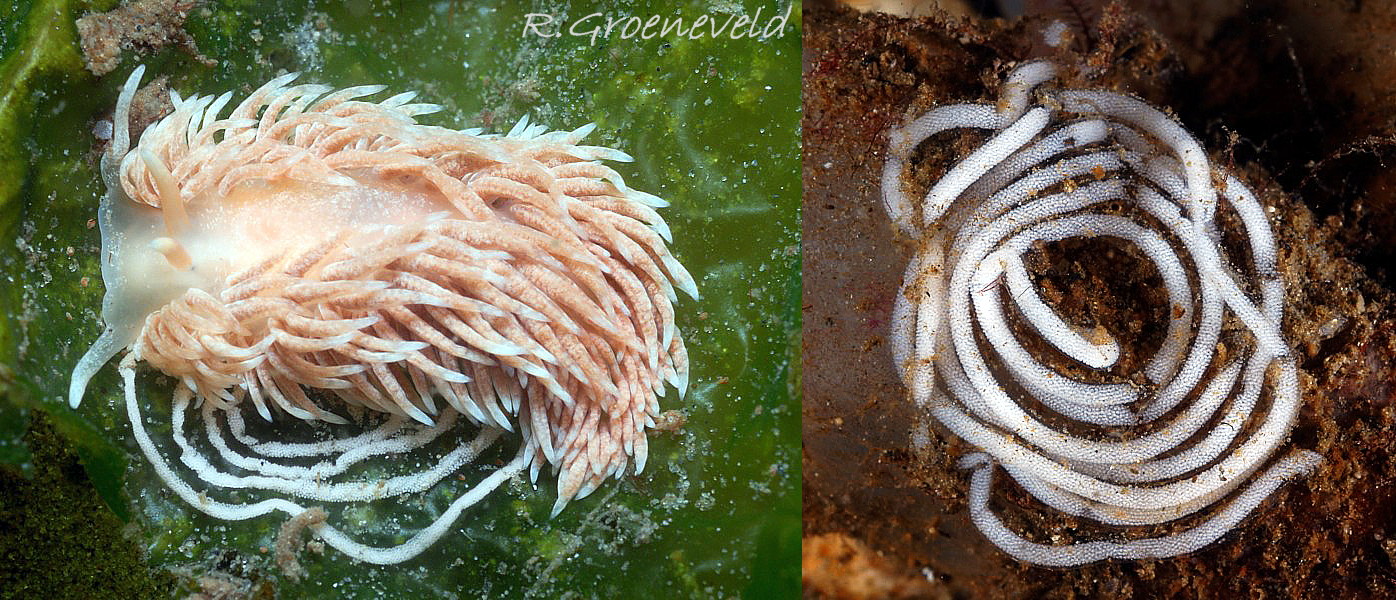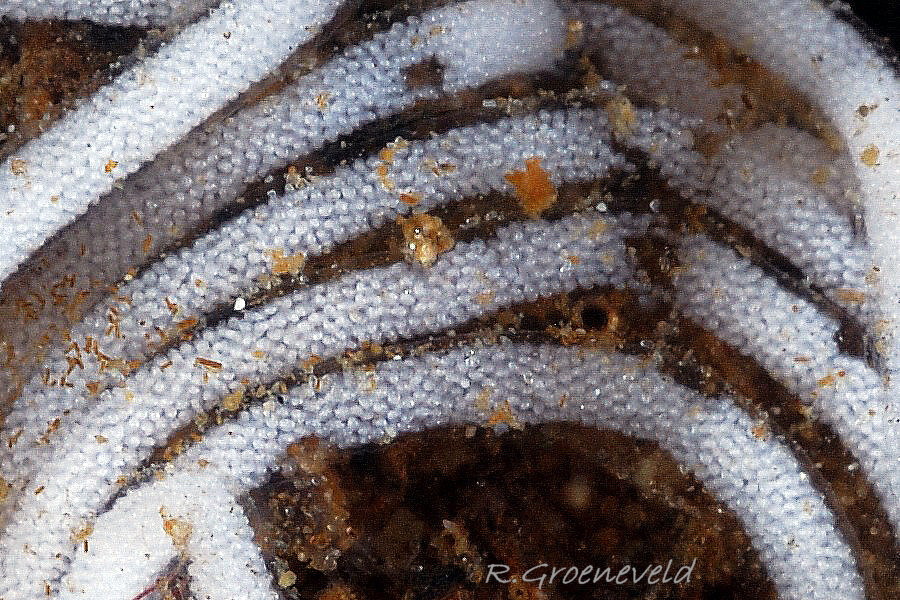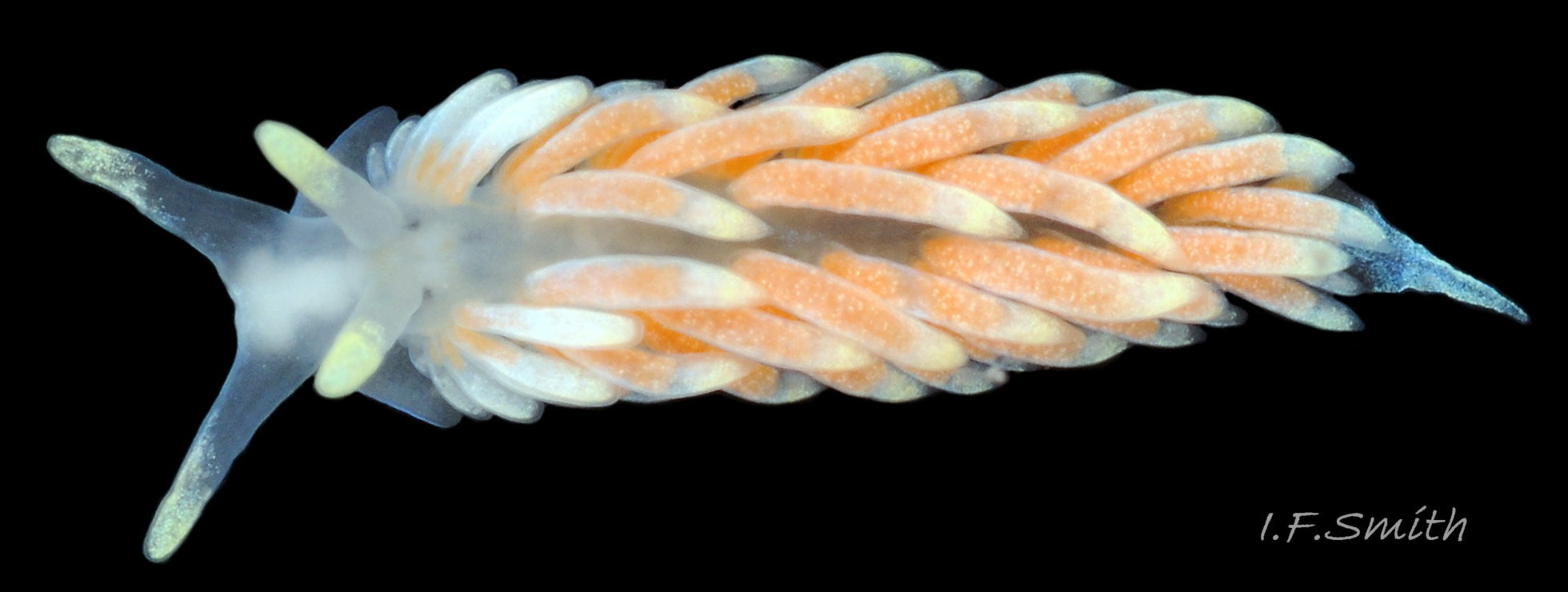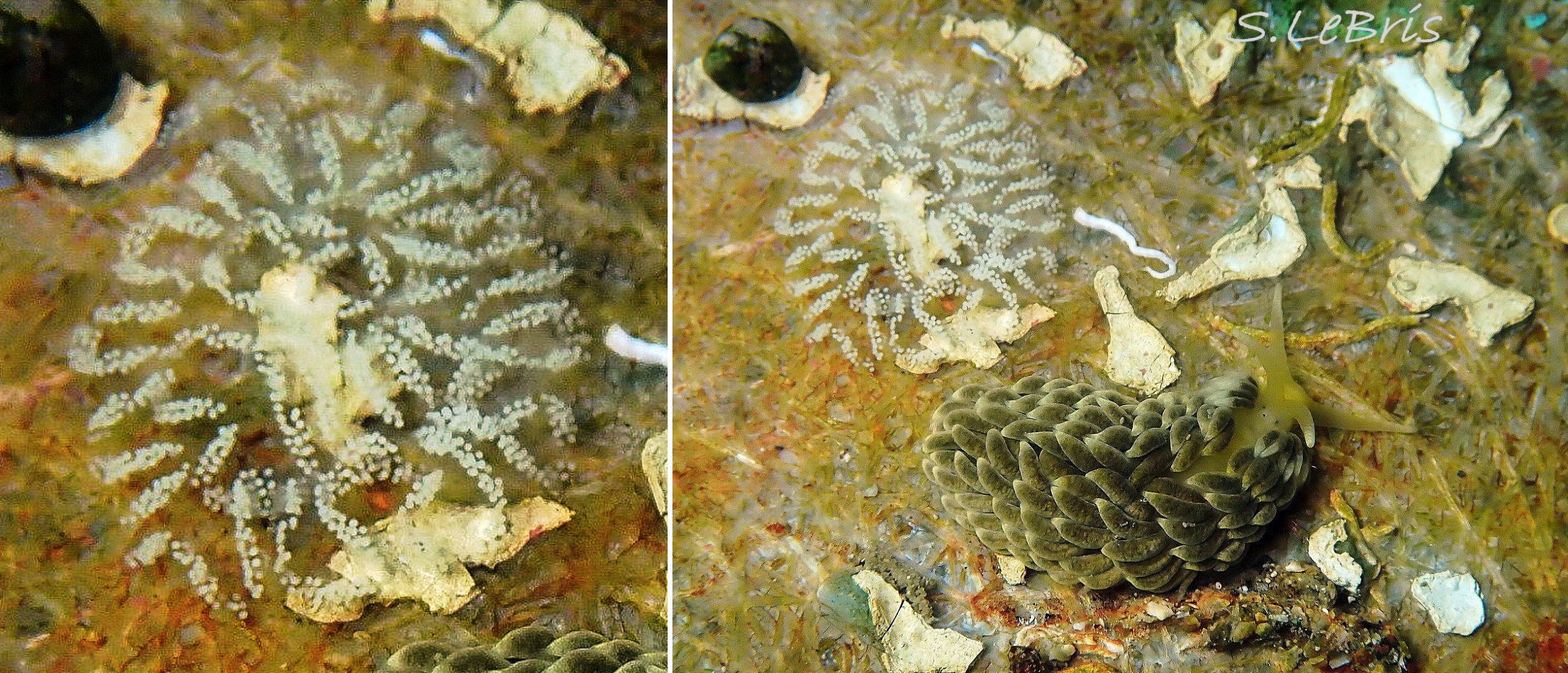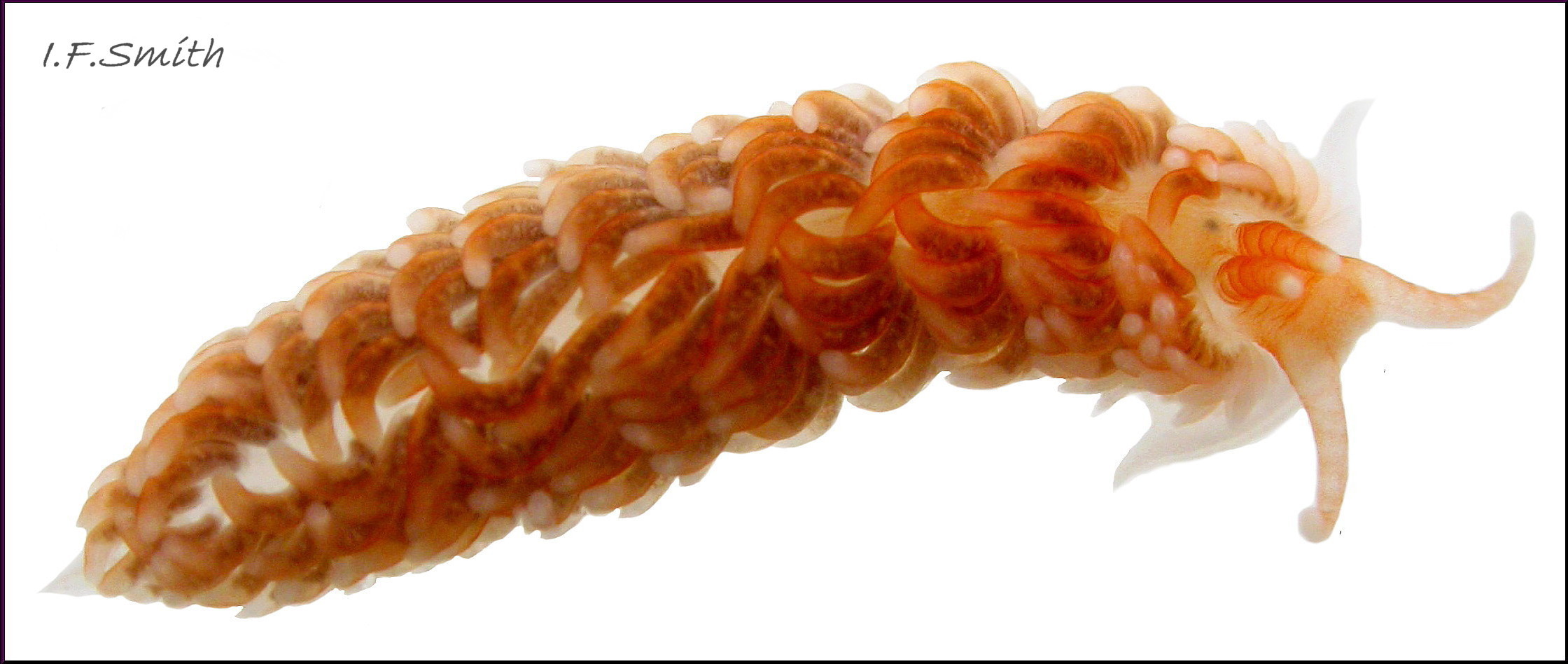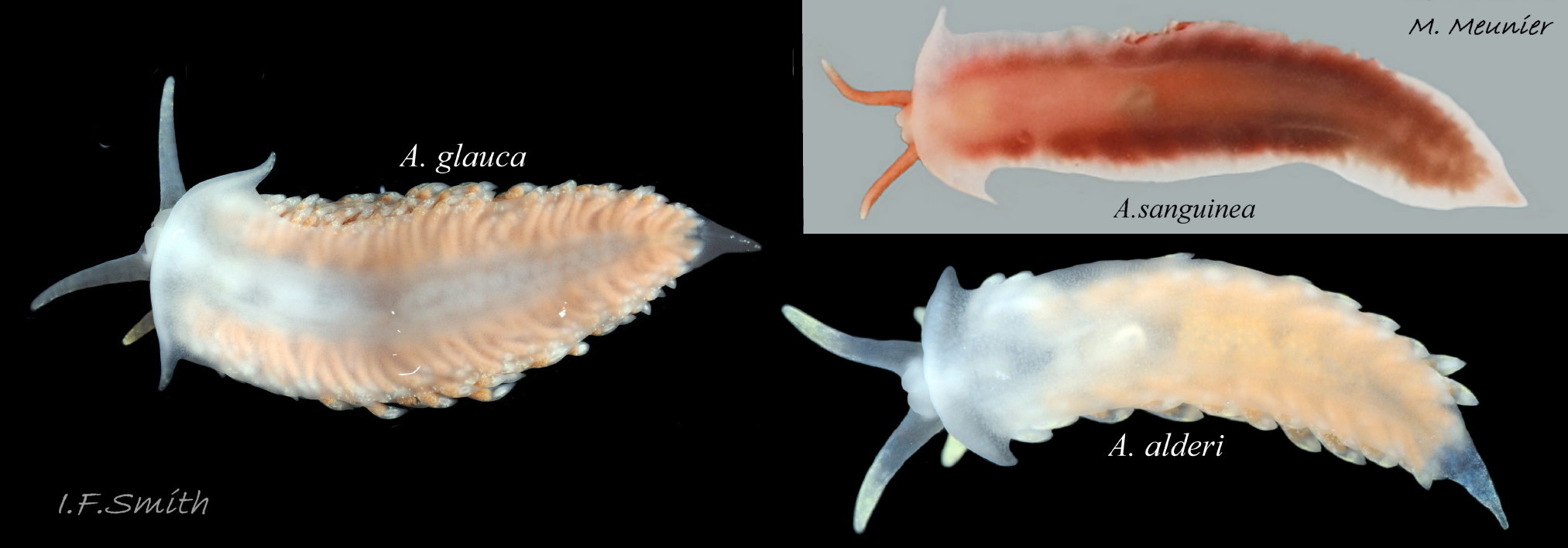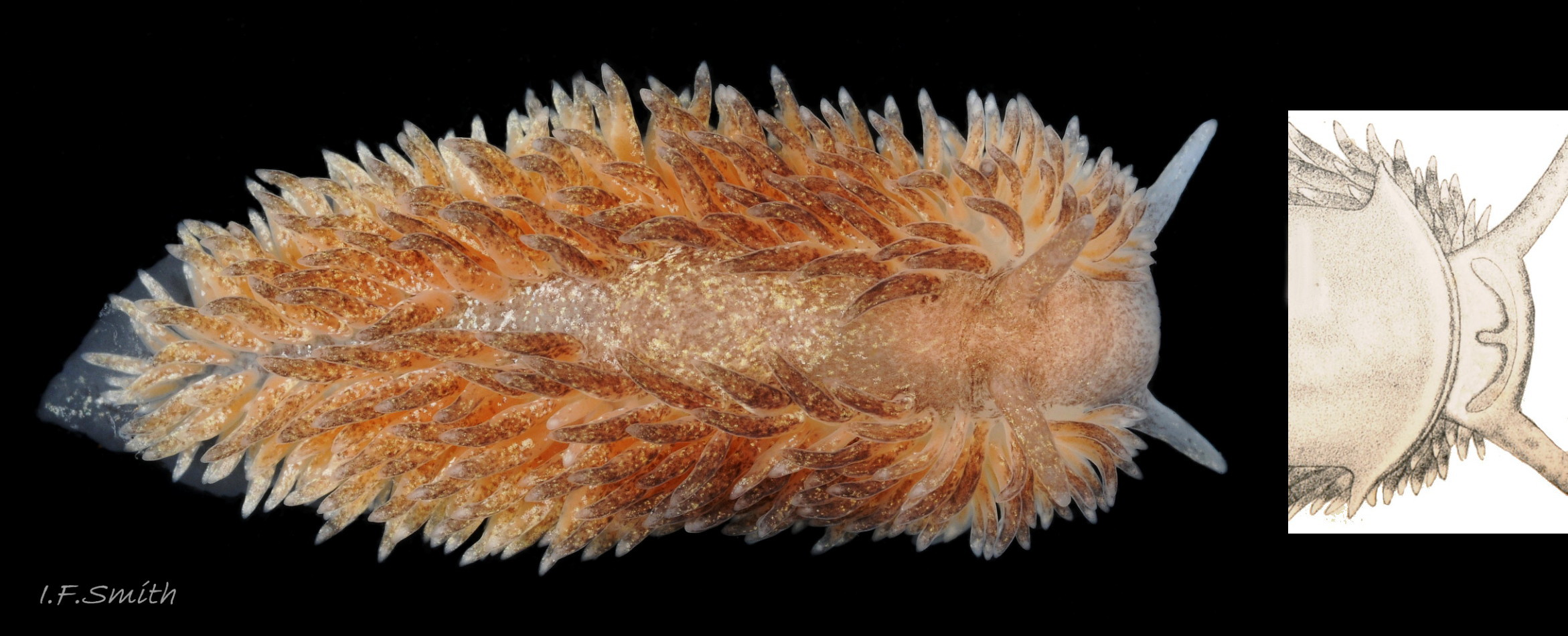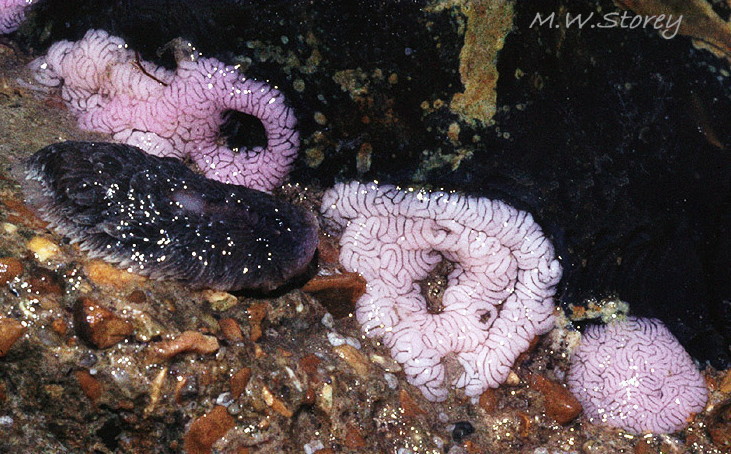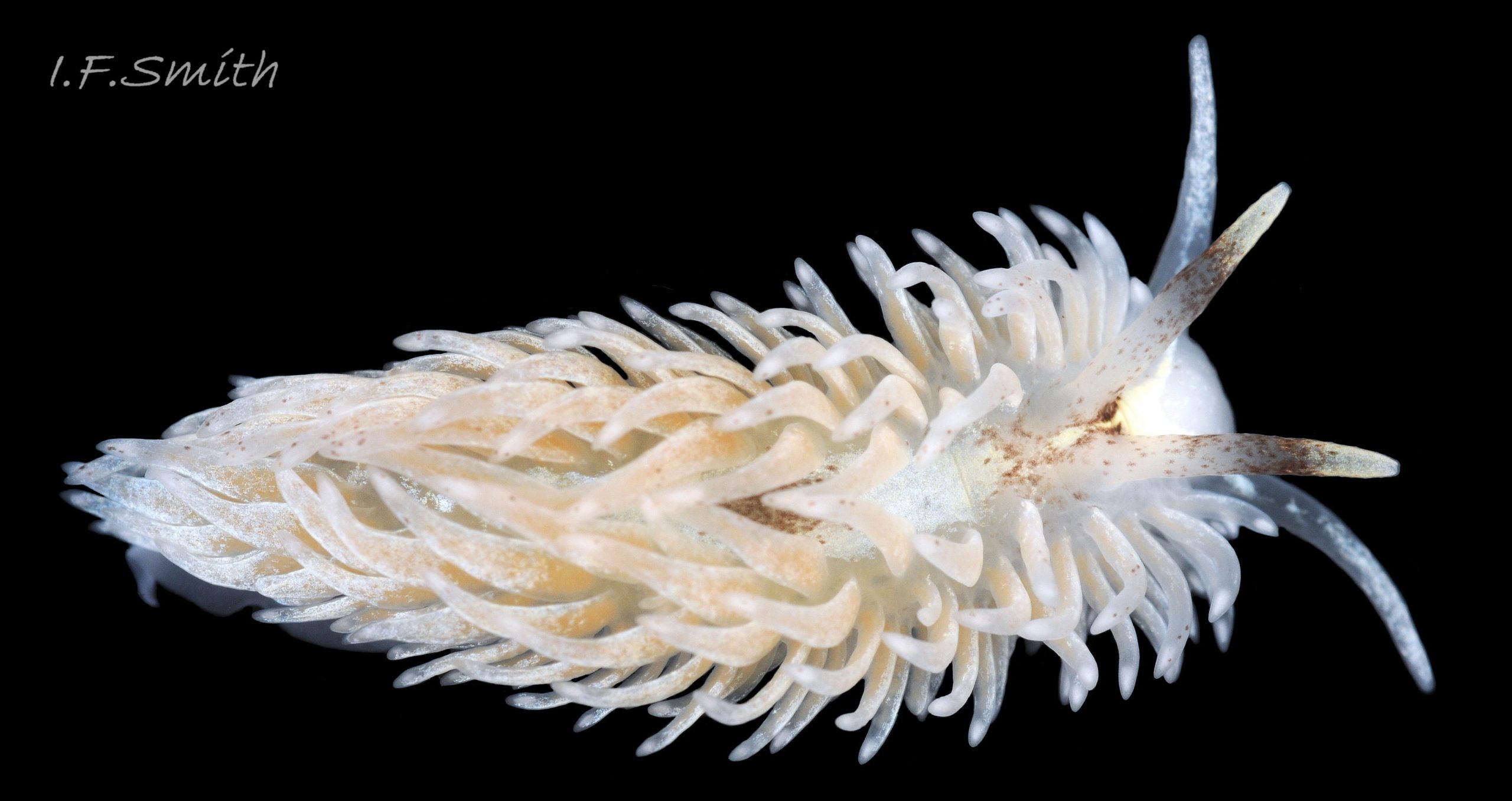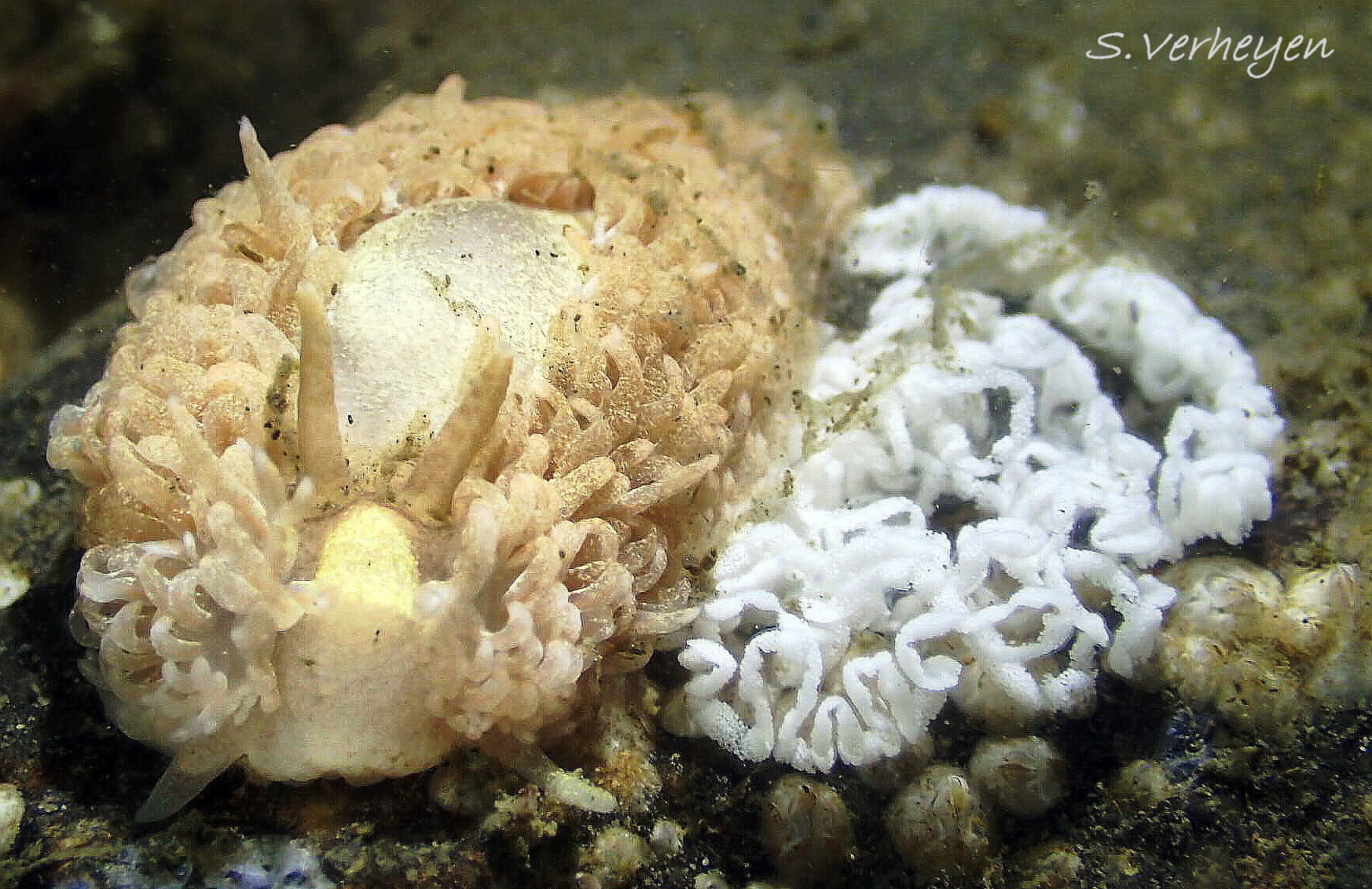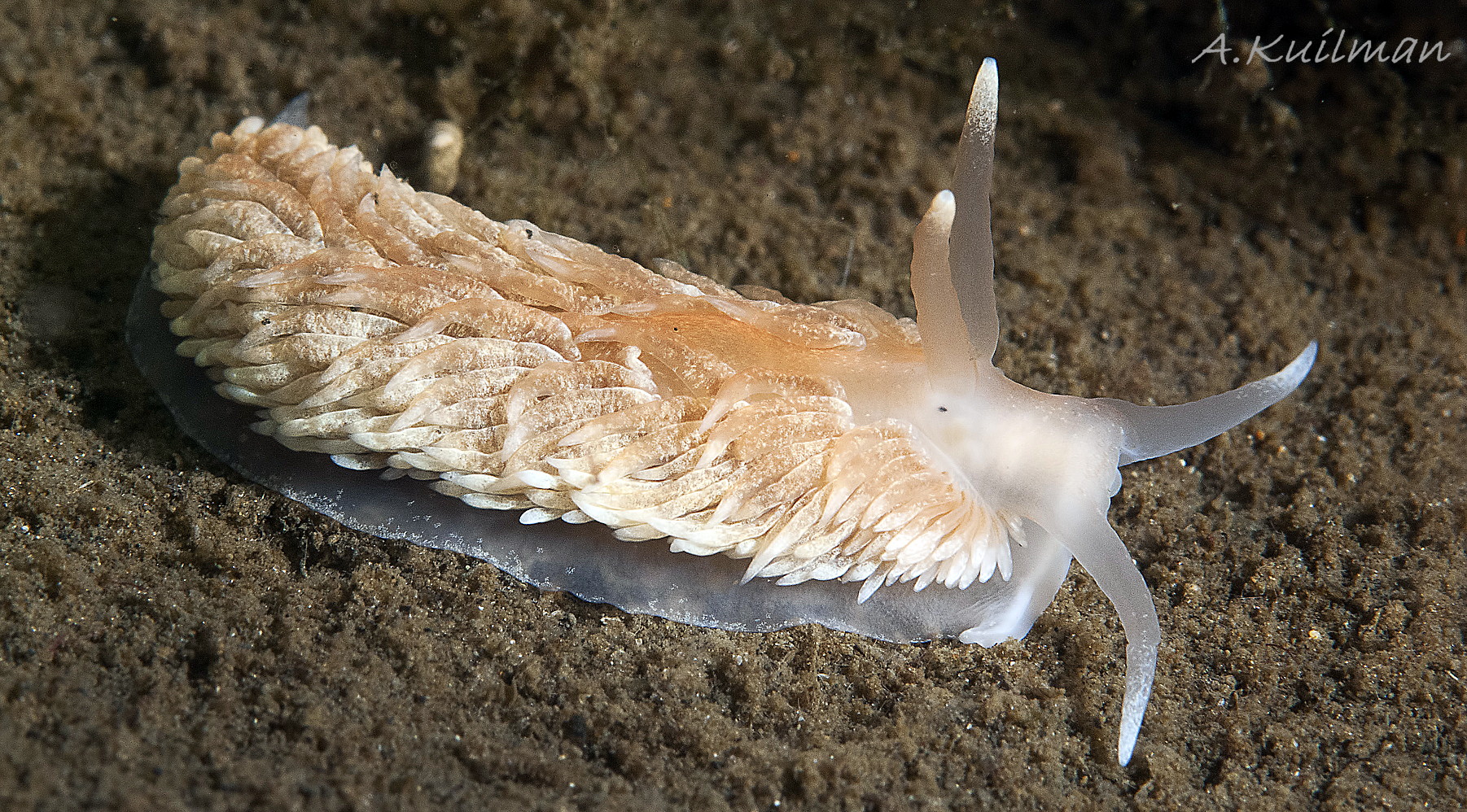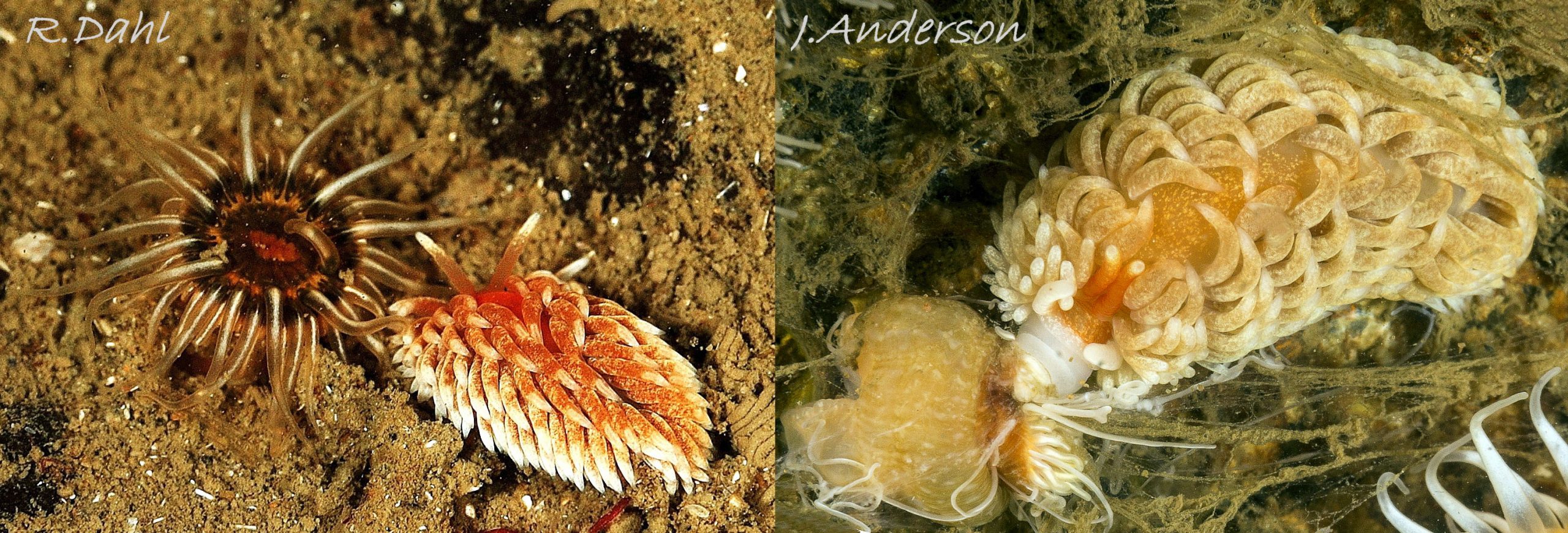Click image to enlarge with full caption. Main text below slider.
Aeolidiella glauca (Alder & Hancock, 1845)
Synonyms: Eolis glauca Alder & Hancock, 1845.
Current taxonomy: World Register of Marine Species www.marinespecies.org/aphia.php?p=taxdetails&id=138711
GLOSSARY BELOW
Description
The body grows up to 40 mm long. It is translucent whitish, often with a fawn, orange 01 Aeolidia glauca or, occasionally, golden 02 Aeolidiella glauca suffusion of varying intensity and extent. The notum has opaque flecks of white 04 Aeolidiella glauca or a whitish shade of the general body tint 01 Aeolidia glauca .
The cerata are arranged in about fifteen transverse rows on each side of the body. They sometimes conceal most of the notum 05 Aeolidiella glauca , but much of it is often exposed 01 Aeolidia glauca . The cerata are translucent white or pinkish revealing a pinkish 03 Aeolidiella glauca , orange-brown 01 Aeolidia glauca or grey-brown 04 Aeolidiella glauca internal digestive gland, with large white cnidosacs at the tip. Some of, but rarely all of, each ceras in the anterior row may be occupied for about half its length by a very large whitish cnidosac 06 Aeolidiella glauca & 05 Aeolidiella glauca to form a white ruff resembling the usually more fully developed one on A. alderi. There is usually extensive opaque whitish mottling on the surface of the cerata 04 Aeolidiella glauca & 07 Aeolidiella glauca .
The smooth, sometimes wrinkled 07 Aeolidiella glauca , translucent rhinophores are usually tinted orange of varying intensity 06 Aeolidiella glauca with an opaque cream-white apical stipple.
The head is translucent white 05 Aeolidiella glauca or tinted orange 01 Aeolidia glauca . Internal eyes visible are visible at the posterior base of the rhinophores, unless hidden by the tilt of a rhinophore 05 Aeolidiella glauca . The internal, opaque white internal jaw and buccal mass are often visible 05 Aeolidiella glauca , and they may be tinted by the overlying translucent integument 08 Aeolidiella glauca . The distance between oral tentacles at their base is about equal to thickness of a single tentacle base 08 Aeolidiella glauca . Oral tentacles translucent white, nearly always without tinting of another colour, and with opaque white flecks 03 Aeolidiella glauca .
The broad foot is three times as wide as the body, narrowing to a slender posterior point 08 Aeolidiella glauca & 09 Aeolidia glauca . The convex anterior continues into short propodial tentacles which often bend forwards at the tip resulting in a sigmoid foot anterior 09 Aeolidia glauca . The sole is usually transparent colourless, clearly revealing the body and its overhanging cerata. Round white ovotestes may be visible through the sole. The dorsal surface of the foot usually has white peripheral pigment flecks 21 Aeolidiella glauca , but they are often hidden by overhanging cerata apart from its protruding posterior 01 Aeolidia glauca or through the sole from below 09 Aeolidia glauca .
Key identification features
Identification should be made with more than one feature as there is some interspecific overlap. For example, a white ruff of anterior cerata can be found on some of all three Aeolidiella species, though it is usually most distinct on A. alderi.
Aeolidiella glauca
1) Maximum length 40 mm (Thompson & Brown, 1984). Body broad 09 Aeolidia glauca in comparison with A. sanguinea and A. alderi . Often, overall pinkish appearance from cerata, especially when viewed through translucent foot.
2) From above, internal eyes usually visible through translucent body 03 Aeolidiella glauca .
3) Anterior cerata may be white and resemble the more fully developed white ruff on A. alderi 06 Aeolidiella glauca & 05 Aeolidiella glauca .
4) Anterior half of body copiously speckled with pale opaque pigment 01 Aeolidia glauca .
5) Distance between oral tentacles about same as thickness of single tentacle base 01 Aeolidia glauca .
6) Anterior edge of foot has short propodial tentacles which may curve forwards at the tip 09 Aeolidia glauca .
7) White pigment stipple on dorsal periphery of foot 21 Aeolidiella glauca & 09 Aeolidia glauca , oral tentacles, cerata and, distally, on rhinophores 03 Aeolidiella glauca .
8) Body translucent white, anterior often translucent orange 01 Aeolidia glauca .
9) Spawn, a plain non-sinuous spiral line 10 Aeolidiella glauca ; white contents divided into sections by clear breaks; ova small so width of spawn line 5 or 6 times diameter of one ovum 11 Aeolidiella glauca .
Similar species
Aeolidiella alderi (Cocks, 1852) 12 Aeolidiella glauca.
1) Maximum length 37 mm (Thompson & Brown, 1984). When extended, fairly robust but more slender than Aeolidia papillosa, A. filomenae and Aeolidiella glauca. Usually straighter than the more slender, sinuous A. sanguinea.
2) From above, internal eyes usually visible through translucent body unless hidden by tilt of rhinophore.
3) Front row of cerata makes a white ruff with white zone in each ceras usually 50% or more of length.
4) No opaque flecks on dorsum.
5) Distance between oral tentacles about same as thickness of single tentacle base .
6) Anterior edge of foot a smooth crescent terminating in short triangular propodial tentacles which do not usually curve forward at the tip .
7) White or yellow pigment distally on rhinophores, oral tentacles and cerata, but no white pigment stipple on dorsal periphery of foot.
8) Body translucent white. Some tinted yellowish or reddish 13 Aeolidiella glauca.
9) Spawn is a deeply sinuous line arranged loosely in a disc 14 Aeolidiella glauca.
Aeolidiella sanguinea (Norman, 1877)
15 Aeolidiella glauca & 16 Aeolidiella glauca .
1) Maximum length 46 mm (Thompson & Brown, 1984). Slender sinuous body is more slender than A. alderi.
2) From above, internal eyes usually visible through translucent body.
3) All cerata have a large white cnidosac slightly tinted by the orange to red surface of the cerata. The front row of cerata can make a white ruff, and the white zone, tinted orange or red, in each ceras can be more than 50% of ceras length. But the ruff is not usually as fully developed as on A. alderi.
4) No opaque flecks on notum.
5) Distance between oral tentacles about same as thickness of single tentacle base.
6) Anterior edge of foot often sigmoid with short propodial tentacles curved forward at tip.
7) No surface pigment on dorsal periphery of foot, oral tentacles or cerata, but rhinophores have distinctly demarcated white tips.
8) Body, rhinophores and cerata are translucent red, orange or yellow,
9) Spawn; a plain spiral line.
Aeolidia papillosa (Linnaeus, 1761) 17 Aeolidiella glauca .
1) Maximum length120 mm (Thompson & Brown, 1984). Body broader than Aeolidiella glauca.
2) Internal eyes not, or barely, visible through opaque pigment.
3) Dull whitish cnidosac visible if not obscured by white apical pigment.
4) Much opaque pigment on dorsum.
5) Distance between oral tentacles about three times thickness of tentacle base.
6) Anterior edge of foot a smooth crescent terminating in short triangular propodial tentacles.
7) Much pigment on rhinophores and cerata. Often dark and whitish pigment stipple on dorsal periphery of foot.
8) Most of body, rhinophores and cerata not translucent.
9) Spawn; large convoluted ribbon, standing upright in water, deposited in spiral 18 Aeolidiella glauca.
Aeolidia filomenae Kienberger, Carmona, Pola, Padula, Gosliner & Cervera, 2016 19 Aeolidiella glauca.
1) Maximum length at least 70 mm. Body broader than Aeolidiella glauca.
2) Internal eyes sometimes faintly visible in light specimens.
3) Apices of cerata are white, often revealing large white cnidosacs.
4) Dorsum white or pale colour with opaque white or brown flecks which may concentrate locally into dense brown markings.
5) Distance between oral tentacles about three times thickness of tentacle base.
6) Anterior edge of foot a smooth crescent terminating in short triangular propodial tentacles.
7) Rhinophores and cerata are translucent with varying amounts of opaque white and brown freckling. Usually no pigment stipple on dorsal surface of foot.
8) Some parts of body and cerata may be translucent.
9) Spawn; large convoluted ribbon, standing upright in water, deposited in spiral 20 Aeolidiella glauca.
Habits and ecology
A. glauca is found sublittorally and, occasionally, at low water spring tide at sheltered sites, usually where there is some mud or silt present; its broad foot supports it on soft sediment 21 Aeolidiella glauca . Thompson & Brown, (1984) list its prey as Sagartiogeton spp., Cylista troglodytes (Price in Johnston, 1847), C. elegans (Dalyell, 1848) 22 Aeolidiella glauca , Cereus pedunculatus (Pennant, 1777) and Diadumene cincta Stephenson, 1925.
Like other nudibranchs, A. glauca is a simultaneous hermaphrodite. Spawn is deposited in a non-sinuous spiral line 10 Aeolidiella glauca . The white ova within are divided into sections by several unoccupied short lengths of the transparent colourless line 11 Aeolidiella glauca . The spawn line is five or six times as wide as the diameters of the small ova 12 Aeolidiella glauca. Veliger larvae hatch from the spawn and drift as plankton before settling on the sea floor and transforming into adults.
Distribution and status
Available online images show that A. glauca occurs from Norway and Faeroe to the Netherlands and the south coast of Britain. Uncertainty about identifications of Aeolidiella records lacking the support of clear images make defining of its southern limit difficult. Thompson and Brown (1984) cited Tardy (1969) as recording it from Arcachon Bay near Bordeaux and said it probably does not occur in the Mediterranean. Some Iberian guides and websites show images of probable A. alderi as A. glauca or, in the absence of local finds, use images of A. glauca from north-west Europe. Careful search online with Google, GBIF, iNaturalist, Flickr and Facebook failed to find any incontestable image of A. glauca in southern Europe. In Britain, some old records aggregate A. alderi with A. glauca but an unmistakable image of A. glauca 23 Aeolidiella glauca from the Lizard, Cornwall, the southernmost tip of Britain, puts beyond doubt that it extends to the south coast of Britain. It is widespread in Britain and Ireland, UK map NBN species.nbnatlas.org/species/NBNSYS0000173623
GBIF map www.gbif.org/species/2291946
Acknowledgements
For use of images I thank Jim Anderson, Roy Dahl, Guy Freeman, Rokus Groeneveld, Arne Kuilman, Sylvain Le Bris, Mathias Meunier and Lou Valence, Malcolm Storey, Stefan Verheyen and Neil Ward. I thank Simon Taylor for specimens, and Marco Faasse for information about sea anemones.
References and links
Alder, J. & Hancock, A. 1845-1855. A monograph of the British nudibranchiate mollusca. London, Ray Society. Family 3, Plate 11. www.biodiversitylibrary.org/item/131598#page/326/mode/1up
Anderson, J. Aeolidiella glauca (Alder & Hancock, 1845), Scottish nudibranchs and sea slugs (accessed 12 November 2022) www.nudibranch.org/Scottish%20Nudibranchs/aeolidiella-gla…
Groeneveld, R. & Reijs, S. (accessed 12 November 2022). Zeenaaktslakken, Nudibranchia. www.diverosa.com/FF_NL/ff_zeenaaktslakken.htm
Tardy, J. 1969. Étude systématique et biologique sur trois espèces d’Aeolidielles des côtes européennes (Gastéropodes Nudibranches). Bull. Inst. Oceanogr. Monaco 68: 1 – 40.
Thompson, T.E. & Brown, G.H. 1984. Biology of opisthobranch molluscs 2. London, Ray Society.
Glossary
acontia = thread-like tissue containing numerous stinging nematocysts which are released by some sea anemones
buccal mass = anterior of digestive system including an odontophore that supports anterior of radula, and a complex of muscles to operate them and other mouthparts.
cerata = (sing. ceras, adj. ceratal) lobes on notum of some nudibranchs.
Cnidaria = hydroids, jellyfish, sea anemones etc. which possess cnidocytes.
cnidocytes = explosive stinging cells of Cnidaria. en.wikipedia.org/wiki/Cnidocyte
cnidosac = storage capsule at tips of cerata of Aeolidiidae for ingested cnidocytes.
digestive gland = large organ in gastropods which acts like the liver and pancreas in mammals to absorb food.
distal = away from centre of body or from point of attachment.
hermaphrodite, simultaneous = individual acts as both male and female at the same time with similar partner.
notum = (of sea slugs) the dorsal surface of the body; the back.
ovotestis = (pl. ovotestes) hermaphrodite organ serving as both ovary and testis.
propodial tentacles = tentacular, lateral extensions on anterior of the foot.
rhinophore = chemo-receptor tentacle; many sea slugs have a pair on top of the head.
veliger = shelled larva which moves by action of cilia on a velum (bilobed flap). Stage may be passed in plankton or within liquid-filled egg-capsule.
